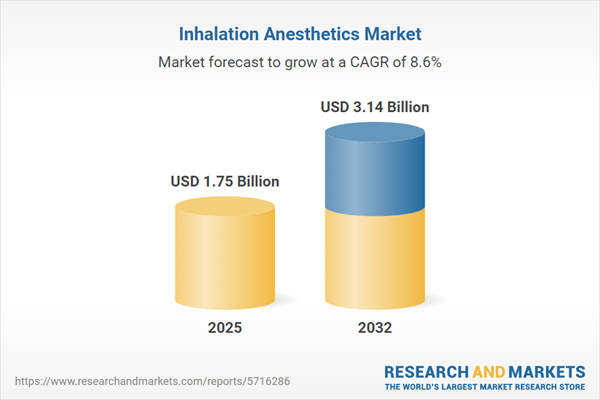Speak directly to the analyst to clarify any post sales queries you may have.
The inhalation anesthetics market is undergoing significant change, influenced by digital transformation in healthcare, new clinical standards, and evolving regulatory expectations. Senior leaders need targeted analysis to adapt strategies, manage supply continuity, and meet the rising focus on sustainability in perioperative environments.
Market Snapshot: Inhalation Anesthetics Market Size and Growth Outlook
The inhalation anesthetics market is valued at USD 1.62 billion in 2024 and is projected to grow to USD 1.75 billion by 2025, with an anticipated compound annual growth rate (CAGR) of 8.63% leading to a market size of USD 3.14 billion by 2032. This steady growth is driven by advancements in anesthesia delivery technology, increased demand for surgical procedures worldwide, and a heightened focus on personalizing anesthesia care. The market tracks broader trends in healthcare, including ongoing digitalization, expansion of specialized surgical services, and expectations for adaptive, patient-centered perioperative management.
Scope & Segmentation of the Inhalation Anesthetics Market
The report delivers a comprehensive breakdown of the inhalation anesthetics market, enabling senior decision-makers to calibrate strategy and operations with market shifts and emerging regulatory frameworks. Segmentation includes:
- Product Types: Gaseous anesthetics and volatile agents, encompassing Desflurane, Enflurane, Halothane, Isoflurane, and Sevoflurane, tailored for diverse surgical and perioperative requirements.
- Age Group: Adult, geriatric, and pediatric populations, ensuring products meet specific physiological and clinical needs across patient demographics.
- Application: Anesthesia induction and maintenance, emphasizing agents preferred for rapid onset, stability, and consistent intraoperative performance.
- End User: Hospitals, ambulatory surgical centers, intensive care units, specialized clinics including military and veterinary settings, and a wide spectrum of healthcare providers to maximize clinical access.
- Distribution Channel: Traditional offline purchases and rising adoption of digital procurement platforms, reflecting transitions in buying patterns and supply chain management.
- Region: Detailed insights for the Americas, Europe, Middle East & Africa, and Asia-Pacific, offering localized perspectives for operational and investment decisions amid dynamic market adoption rates.
- Leading Companies: Industry players such as Baxter International Inc., Halocarbon Life Sciences, Lunan Pharmaceutical Group, AbbVie Inc., Piramal Enterprises, Fresenius Kabi AG, and Hikma Pharmaceuticals, each advancing the field through R&D and partnership networks.
Key Takeaways and Strategic Insights
- Upgrades in vaporizer technology and integration of advanced patient monitoring equip clinicians with tools for reliable anesthesia delivery and workflow integration.
- Personalized anesthetic approaches are increasingly feasible, supported by pharmacokinetic modeling and genetic analysis to optimize patient safety and dosing strategies for various populations.
- There is a growing focus on sustainable anesthetic agents and eco-friendly processes, as manufacturers and healthcare leaders pursue reduced emissions throughout the clinical workflow.
- Organizations are fortifying supply chains by adopting localized production and distributed sourcing, proactively addressing regulatory complexity and global trade variability.
- The Asia-Pacific region and select emerging markets show robust uptake of innovative anesthesia solutions due to infrastructure investments and broader access to perioperative care.
Tariff Impact: Supply Chain and Sourcing Shifts
With the introduction of tariffs in 2025, sourcing and cost structures for inhalation anesthetics are evolving. Organizations are responding by broadening sourcing models, investing in local manufacturing, and deploying advanced inventory management solutions. These adjustments ensure operational resilience amid regulatory changes and international trade pressures.
Methodology & Data Sources
Research findings are based on primary interviews with anesthesiologists, procurement managers, and regulatory officials, supplemented and verified through peer-reviewed journals and official healthcare publications for balanced, accurate insights.
Why This Report Matters for Senior Decision-Makers
- Helps inform investments in technology integration, product development, and identification of high-potential regional opportunities in response to market and clinical trends.
- Supports benchmarking and planning by mapping regulatory shifts and evolving supply chain models, contributing to resilient operations.
- Offers strategic guidance for implementing sustainable initiatives that align with environmental and legislative best practices in perioperative anesthesia care.
Conclusion
Continual market monitoring and responsive strategy are essential as the inhalation anesthetics sector transforms. Organizations that leverage clear intelligence and forward-focused planning can navigate challenges and build sustainable competitive positions.
Additional Product Information:
- Purchase of this report includes 1 year online access with quarterly updates.
- This report can be updated on request. Please contact our Customer Experience team using the Ask a Question widget on our website.
Table of Contents
3. Executive Summary
4. Market Overview
7. Cumulative Impact of Artificial Intelligence 2025
List of Figures
Samples

LOADING...
Companies Mentioned
The key companies profiled in this Inhalation Anesthetics market report include:- Baxter International Inc.
- Halocarbon Life Sciences
- Lunan Pharmaceutical Group Co. Ltd.
- AbbVie Inc.
- Piramal Enterprises Limited
- Fresenius Kabi AG
- Hikma Pharmaceuticals PLC
- Troikaa Pharmaceuticals Ltd.
- Maruishi Pharmaceutical Co., Ltd.
- Pfizer Inc.
- Jiangsu Hengrui Medicine Co., Ltd.
- Yichang Humanwell Pharmaceutical Co., Ltd.
- Zoetis Inc.
- Draegerwerk AG & Co. KGaA
- Linde PLC
- Dechra Pharmaceuticals PLC
- Halocarbon Products Corporation
- RAMAN WEIL
- Piramal Critical Care Limited
- Aetos Pharma Private Limited
- NextSource Pharma
- Dechra Veterinary Products
Table Information
| Report Attribute | Details |
|---|---|
| No. of Pages | 193 |
| Published | October 2025 |
| Forecast Period | 2025 - 2032 |
| Estimated Market Value ( USD | $ 1.75 Billion |
| Forecasted Market Value ( USD | $ 3.14 Billion |
| Compound Annual Growth Rate | 8.6% |
| Regions Covered | Global |
| No. of Companies Mentioned | 23 |









